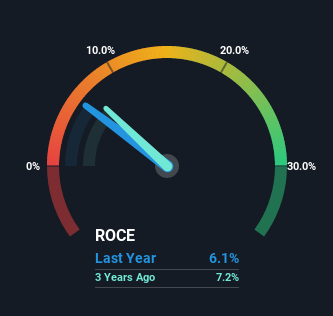- India
- /
- Auto Components
- /
- NSEI:APOLLOTYRE
Apollo Tyres (NSE:APOLLOTYRE) May Have Issues Allocating Its Capital

If you're not sure where to start when looking for the next multi-bagger, there are a few key trends you should keep an eye out for. Amongst other things, we'll want to see two things; firstly, a growing return on capital employed (ROCE) and secondly, an expansion in the company's amount of capital employed. Basically this means that a company has profitable initiatives that it can continue to reinvest in, which is a trait of a compounding machine. In light of that, when we looked at Apollo Tyres (NSE:APOLLOTYRE) and its ROCE trend, we weren't exactly thrilled.
What is Return On Capital Employed (ROCE)?
For those that aren't sure what ROCE is, it measures the amount of pre-tax profits a company can generate from the capital employed in its business. The formula for this calculation on Apollo Tyres is:
Return on Capital Employed = Earnings Before Interest and Tax (EBIT) ÷ (Total Assets - Current Liabilities)
0.061 = ₹12b ÷ (₹267b - ₹75b) (Based on the trailing twelve months to March 2022).
Thus, Apollo Tyres has an ROCE of 6.1%. Ultimately, that's a low return and it under-performs the Auto Components industry average of 11%.
View our latest analysis for Apollo Tyres

In the above chart we have measured Apollo Tyres' prior ROCE against its prior performance, but the future is arguably more important. If you'd like, you can check out the forecasts from the analysts covering Apollo Tyres here for free.
What The Trend Of ROCE Can Tell Us
On the surface, the trend of ROCE at Apollo Tyres doesn't inspire confidence. To be more specific, ROCE has fallen from 13% over the last five years. Although, given both revenue and the amount of assets employed in the business have increased, it could suggest the company is investing in growth, and the extra capital has led to a short-term reduction in ROCE. And if the increased capital generates additional returns, the business, and thus shareholders, will benefit in the long run.
The Key Takeaway
In summary, despite lower returns in the short term, we're encouraged to see that Apollo Tyres is reinvesting for growth and has higher sales as a result. These growth trends haven't led to growth returns though, since the stock has fallen 12% over the last five years. As a result, we'd recommend researching this stock further to uncover what other fundamentals of the business can show us.
Apollo Tyres could be trading at an attractive price in other respects, so you might find our free intrinsic value estimation on our platform quite valuable.
While Apollo Tyres isn't earning the highest return, check out this free list of companies that are earning high returns on equity with solid balance sheets.
New: Manage All Your Stock Portfolios in One Place
We've created the ultimate portfolio companion for stock investors, and it's free.
• Connect an unlimited number of Portfolios and see your total in one currency
• Be alerted to new Warning Signs or Risks via email or mobile
• Track the Fair Value of your stocks
Have feedback on this article? Concerned about the content? Get in touch with us directly. Alternatively, email editorial-team (at) simplywallst.com.
This article by Simply Wall St is general in nature. We provide commentary based on historical data and analyst forecasts only using an unbiased methodology and our articles are not intended to be financial advice. It does not constitute a recommendation to buy or sell any stock, and does not take account of your objectives, or your financial situation. We aim to bring you long-term focused analysis driven by fundamental data. Note that our analysis may not factor in the latest price-sensitive company announcements or qualitative material. Simply Wall St has no position in any stocks mentioned.
About NSEI:APOLLOTYRE
Apollo Tyres
Manufactures and sells automotive tires, tubes, and flaps in the Asia Pacific, the Middle East, Africa, Europe, and internationally.
Flawless balance sheet established dividend payer.
Similar Companies
Market Insights
Community Narratives



